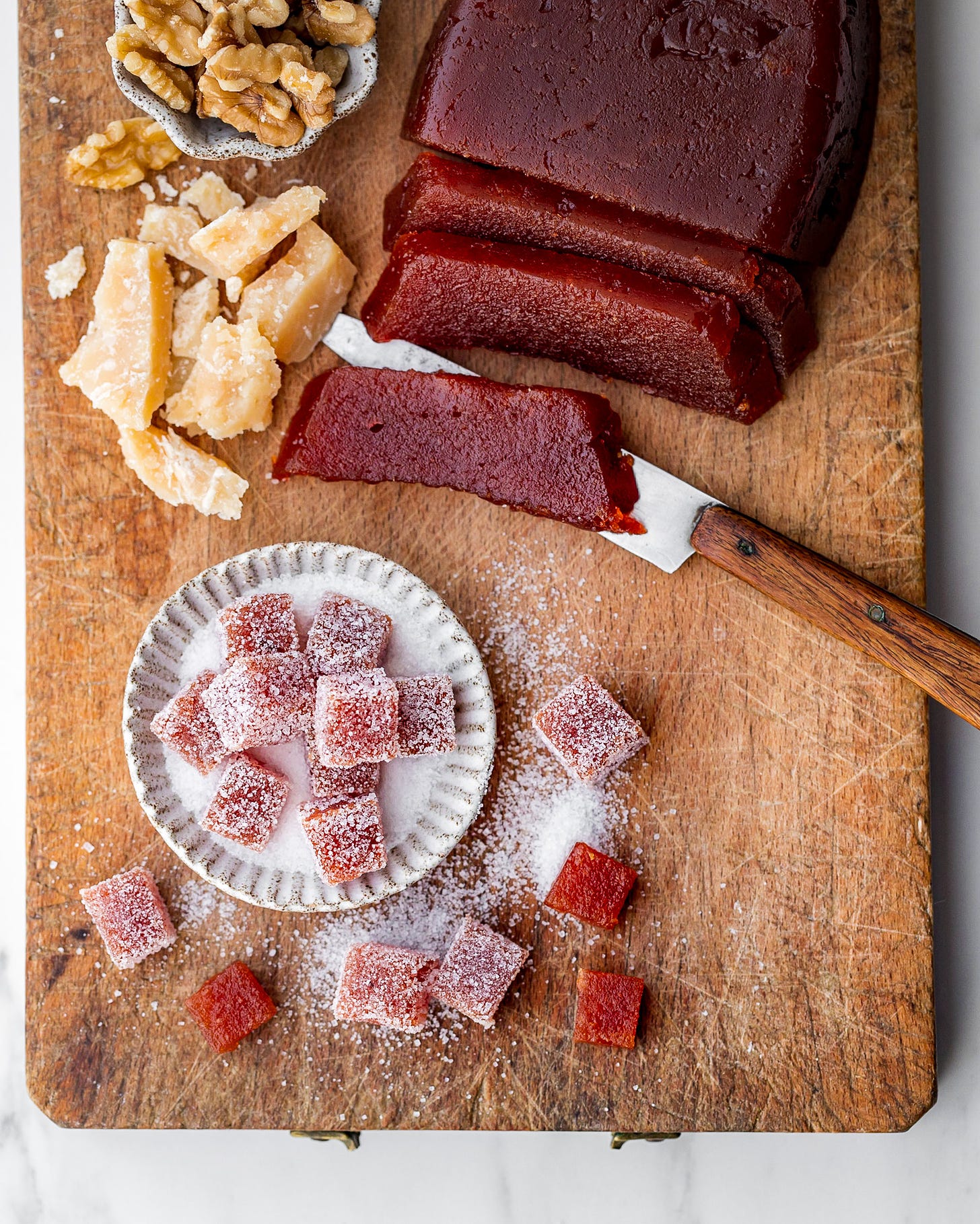Quinces: transforming the inedible into a sweet treat
A quince paste to elevate your cheese board or craft natural gelée candies
As I type at my desk, the fire casts a warm, flickering glow across the living room. Noa and Teo, our two rescued dogs, share the comfort of a carpet near the wood-burning stove. Outside, a thick veil of mist blankets the hills, making it feel as though we’re floating in a cloud.
I wait for these days all year—the fog that softly outlines the silhouettes of the hills and the pom-pom trees in the distance, the cheek-tingling warmth of a roaring fire, the quiet hours that I can finally call my own, and the delicate fragrance of quinces, sitting in a bowl on the kitchen table.
On this gloomy November day, I want to share a love letter to quinces—one of the fruits that make winter a season to love and savor.
Before diving into today’s newsletter, here’s a quick reminder of what’s new:
A season of gratitude and gatherings. Seasonal recipes, the joy of sharing simple food, and a sneak peek at our upcoming 2025 masterclasses.
The art of Pici: Tuscany’s handmade pasta tradition. Learn, cook, and enjoy fresh pasta at your own pace, plus three recipes to dress them.
And for those celebrating, Happy Thanksgiving!
A love letter to quinces
Quinces are knobbly, woody, and inedible when eaten raw. Yet, their floral, fruity fragrance can linger in a kitchen for months, hinting at the magic they hold within. When cooked with sugar, these unassuming fruits reveal their potential and undergo a remarkable transformation: their dry, ligneous flesh becomes butter-soft, and their pale color deepens into every shade of red. Thanks to their high pectin content, quinces easily turn into clear ruby-red jelly, dense jam, or—most traditionally—cotognata, a thick, dark red fruit paste beloved in every Italian region, from Trentino Alto Adige to Puglia and Sicily.
The process begins with patience.
Quarter the quinces and cut them into wedges, but don’t peel or deseed them—this is where the pectin is stocked. After cooking the fruit down into a buttery mess, pass it through a food mill to remove seeds and peels, then cook the purée again with sugar until it turns a deep ruby red. Finally, spoon the now thick quince paste into shallow trays brushed with oil to set.
In Sicily, where cotognata has a long tradition dating back to Spanish domination, quince paste is aged in ancient glazed terracotta molds, often adorned with intricate religious motifs, floral designs, geometric patterns, or even grotesque masks.
Once cured for at least a month—but cotognata can last for well over a year—you’ll have a thick, dry paste that can be sliced like cheese. The possibilities are endless: wrap little bricks as edible gifts, or cut the paste into cubes and coat them with sugar to create natural gelée candies.
I always keep a stash of cotognata in my pantry, wrapped in wax paper. It’s my secret weapon for elevating a cheese board: a fat slice of quince paste alongside walnuts, oat crackers, and a wedge of cheese. Cotognata marries beautifully mature goat or sheep cheese, or even some pungent blue cheese.
Are quinces a part of your fall kitchen traditions? Share your favorite ways to use them, or tag me on Instagram with your creations!
RECIPE - COTOGNATA, QUINCE PASTE
This recipe was originally planned for Cucina Povera. In the process of editing the cookbook, we had to make some tough decisions—those infamous kill your darlings moments. Two entire chapters were left out to allow the remaining recipes to truly shine, and cotognata was one of the treasures that didn’t make it. But I knew it deserved a special spotlight. That moment has finally arrived.
The same thing happened last year with taralli. Why not make those, too, and serve them alongside your cotognata for a festive aperitivo? A plate of crunchy taralli paired with a slice of quince paste, a few cheeses, and a glass of wine could be the start of a beautiful holiday gathering.







